Taxation Law: Analyzing Capital Gains Tax and Income Assessment
VerifiedAdded on 2023/06/03
|22
|6093
|316
Homework Assignment
AI Summary
This assignment provides a detailed analysis of taxation law, focusing on the calculation of taxable income and tax payable. It examines capital gains tax (CGT) events, including the sale of an investment property, stamp collection, and shares, while also considering carry-forward losses and the quarantining rule for collectables. The assignment further explores the characterization of receipts as ordinary income from business activities, including professional fees, dividends, and rental income, and discusses allowable deductions such as office rent and employee salaries. It references relevant sections of the ITAA 1997 and ITAA 1936, as well as case law, to support its analysis of various income and deduction items, providing a comprehensive overview of the taxation principles involved. This document is available on Desklib, a platform offering a range of study tools and solved assignments for students.

Running head: TAXATION LAW
Taxation Law
Name of the Student
Name of the University
Authors Note
Course ID
Taxation Law
Name of the Student
Name of the University
Authors Note
Course ID
Paraphrase This Document
Need a fresh take? Get an instant paraphrase of this document with our AI Paraphraser
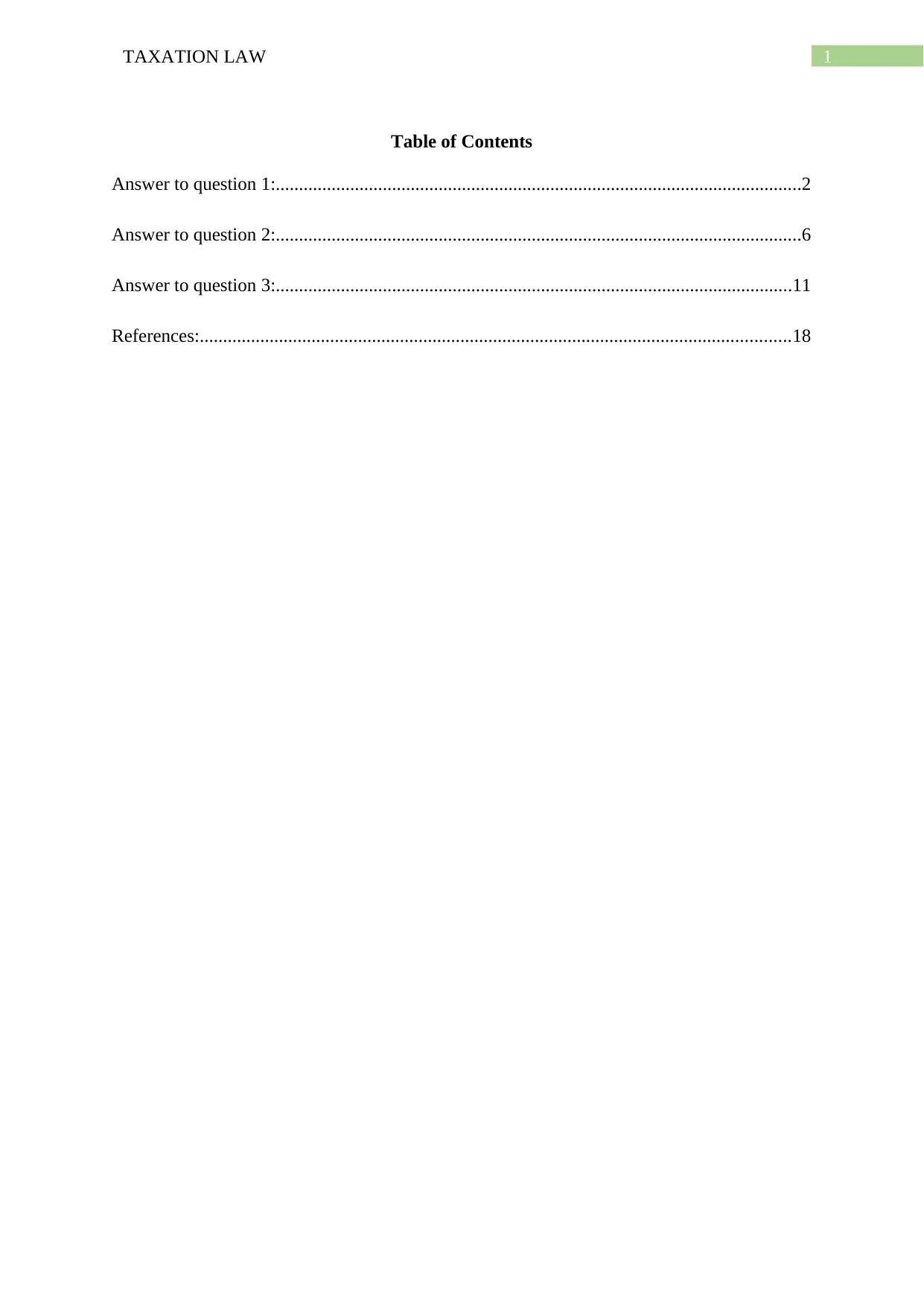
1TAXATION LAW
Table of Contents
Answer to question 1:.................................................................................................................2
Answer to question 2:.................................................................................................................6
Answer to question 3:...............................................................................................................11
References:...............................................................................................................................18
Table of Contents
Answer to question 1:.................................................................................................................2
Answer to question 2:.................................................................................................................6
Answer to question 3:...............................................................................................................11
References:...............................................................................................................................18

2TAXATION LAW
Answer to question 1:
According to the Australian taxation office an individual tax payer may make a
capital gains or capital loss when they sell the rental property that is acquired on or after 19th
September 1985. In the circumstances of the sale or disposal or the real estate the time of the
event is treated normally when a person enters into the contract usually when the settlement
is reached (Sadiq et al. 2013). A person may make the capital gains from the sale of the rental
property up to the extent that the capital proceeds that is received by them is greater than the
cost base of the property. A taxpayer might make the capital loss up to the extent that the
property reduce cost base is greater than the capital proceeds.
A gain is treated as the capital gains which is not subjected to income tax under the
ordinary concepts. The income tax liability of the taxpayer includes the net capital gains. In
other words, the net capital gains is included into the assessable income of the taxpayers
(Woellner et al. 2016). The cost base and the reduced cost base of the property comprises of
the amount that is paid for along with the certain incidental costs that are related with
acquiring, holding and selling the property. This includes the legal fees, stamp duty and real
estate agent commission.
A CGT event A1 occurs under “section 104-10 (1) of the ITAA 1997” when the
taxpayer sells any CGT asset. In the current situation it is noticed that Kylie sold an
investment property for $580,000. The selling of investment apartment resulted in “CGT
event A1” under “section 104-10 (1) of the ITAA 1997” (Braithwaite 2017). The apartment
was however bought for $360,000. At the time of acquiring the holiday apartment Kylie
reported an expenses of $5000 and $4000 respectively for stamp duty and valuation costs.
According to the “section 110-25” the cost base of the asset includes the total amount of
money paid to acquire the property. With reference to “section 110-25” expenses on stamp
Answer to question 1:
According to the Australian taxation office an individual tax payer may make a
capital gains or capital loss when they sell the rental property that is acquired on or after 19th
September 1985. In the circumstances of the sale or disposal or the real estate the time of the
event is treated normally when a person enters into the contract usually when the settlement
is reached (Sadiq et al. 2013). A person may make the capital gains from the sale of the rental
property up to the extent that the capital proceeds that is received by them is greater than the
cost base of the property. A taxpayer might make the capital loss up to the extent that the
property reduce cost base is greater than the capital proceeds.
A gain is treated as the capital gains which is not subjected to income tax under the
ordinary concepts. The income tax liability of the taxpayer includes the net capital gains. In
other words, the net capital gains is included into the assessable income of the taxpayers
(Woellner et al. 2016). The cost base and the reduced cost base of the property comprises of
the amount that is paid for along with the certain incidental costs that are related with
acquiring, holding and selling the property. This includes the legal fees, stamp duty and real
estate agent commission.
A CGT event A1 occurs under “section 104-10 (1) of the ITAA 1997” when the
taxpayer sells any CGT asset. In the current situation it is noticed that Kylie sold an
investment property for $580,000. The selling of investment apartment resulted in “CGT
event A1” under “section 104-10 (1) of the ITAA 1997” (Braithwaite 2017). The apartment
was however bought for $360,000. At the time of acquiring the holiday apartment Kylie
reported an expenses of $5000 and $4000 respectively for stamp duty and valuation costs.
According to the “section 110-25” the cost base of the asset includes the total amount of
money paid to acquire the property. With reference to “section 110-25” expenses on stamp
⊘ This is a preview!⊘
Do you want full access?
Subscribe today to unlock all pages.

Trusted by 1+ million students worldwide
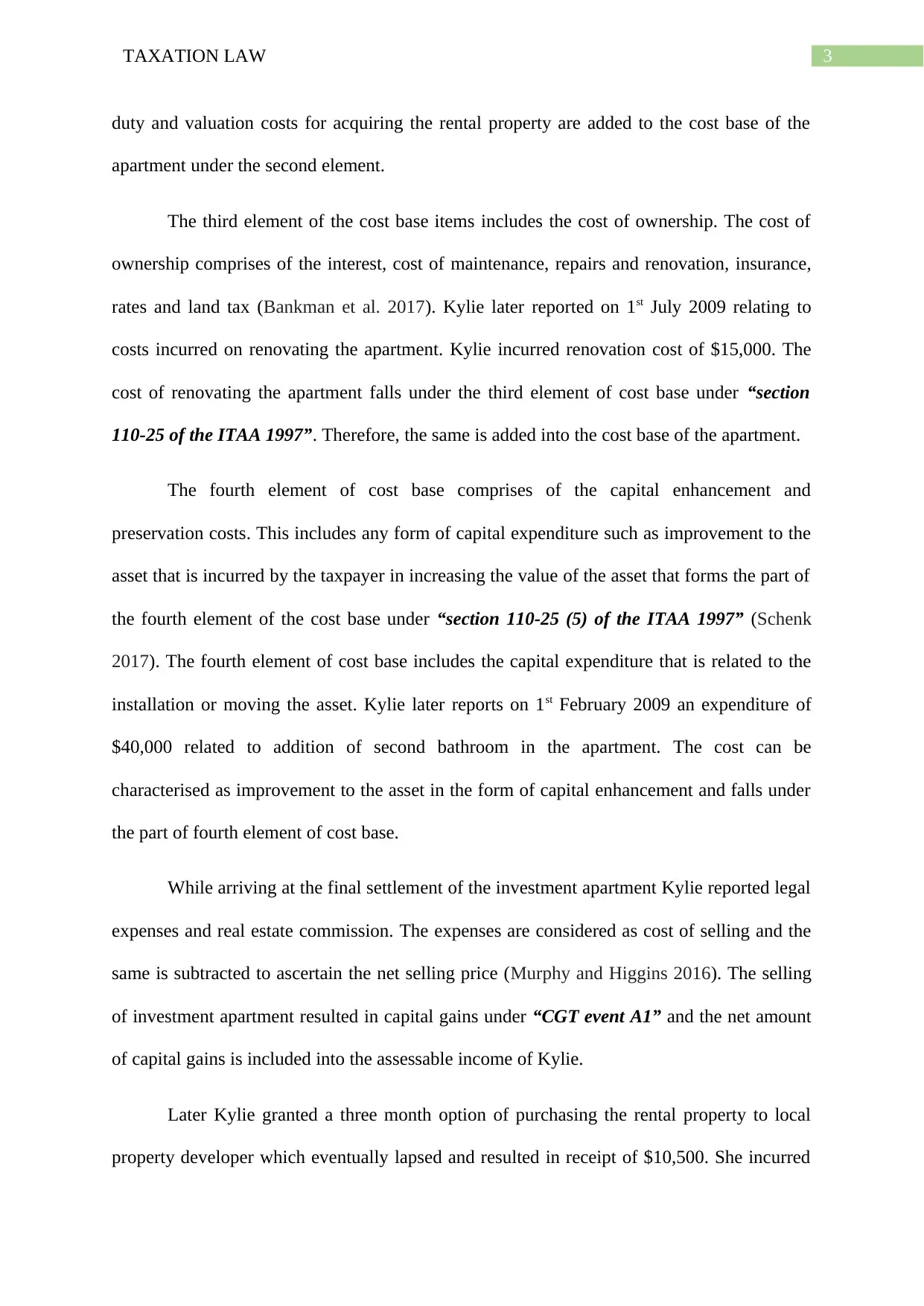
3TAXATION LAW
duty and valuation costs for acquiring the rental property are added to the cost base of the
apartment under the second element.
The third element of the cost base items includes the cost of ownership. The cost of
ownership comprises of the interest, cost of maintenance, repairs and renovation, insurance,
rates and land tax (Bankman et al. 2017). Kylie later reported on 1st July 2009 relating to
costs incurred on renovating the apartment. Kylie incurred renovation cost of $15,000. The
cost of renovating the apartment falls under the third element of cost base under “section
110-25 of the ITAA 1997”. Therefore, the same is added into the cost base of the apartment.
The fourth element of cost base comprises of the capital enhancement and
preservation costs. This includes any form of capital expenditure such as improvement to the
asset that is incurred by the taxpayer in increasing the value of the asset that forms the part of
the fourth element of the cost base under “section 110-25 (5) of the ITAA 1997” (Schenk
2017). The fourth element of cost base includes the capital expenditure that is related to the
installation or moving the asset. Kylie later reports on 1st February 2009 an expenditure of
$40,000 related to addition of second bathroom in the apartment. The cost can be
characterised as improvement to the asset in the form of capital enhancement and falls under
the part of fourth element of cost base.
While arriving at the final settlement of the investment apartment Kylie reported legal
expenses and real estate commission. The expenses are considered as cost of selling and the
same is subtracted to ascertain the net selling price (Murphy and Higgins 2016). The selling
of investment apartment resulted in capital gains under “CGT event A1” and the net amount
of capital gains is included into the assessable income of Kylie.
Later Kylie granted a three month option of purchasing the rental property to local
property developer which eventually lapsed and resulted in receipt of $10,500. She incurred
duty and valuation costs for acquiring the rental property are added to the cost base of the
apartment under the second element.
The third element of the cost base items includes the cost of ownership. The cost of
ownership comprises of the interest, cost of maintenance, repairs and renovation, insurance,
rates and land tax (Bankman et al. 2017). Kylie later reported on 1st July 2009 relating to
costs incurred on renovating the apartment. Kylie incurred renovation cost of $15,000. The
cost of renovating the apartment falls under the third element of cost base under “section
110-25 of the ITAA 1997”. Therefore, the same is added into the cost base of the apartment.
The fourth element of cost base comprises of the capital enhancement and
preservation costs. This includes any form of capital expenditure such as improvement to the
asset that is incurred by the taxpayer in increasing the value of the asset that forms the part of
the fourth element of the cost base under “section 110-25 (5) of the ITAA 1997” (Schenk
2017). The fourth element of cost base includes the capital expenditure that is related to the
installation or moving the asset. Kylie later reports on 1st February 2009 an expenditure of
$40,000 related to addition of second bathroom in the apartment. The cost can be
characterised as improvement to the asset in the form of capital enhancement and falls under
the part of fourth element of cost base.
While arriving at the final settlement of the investment apartment Kylie reported legal
expenses and real estate commission. The expenses are considered as cost of selling and the
same is subtracted to ascertain the net selling price (Murphy and Higgins 2016). The selling
of investment apartment resulted in capital gains under “CGT event A1” and the net amount
of capital gains is included into the assessable income of Kylie.
Later Kylie granted a three month option of purchasing the rental property to local
property developer which eventually lapsed and resulted in receipt of $10,500. She incurred
Paraphrase This Document
Need a fresh take? Get an instant paraphrase of this document with our AI Paraphraser

4TAXATION LAW
the expense of $500 as the fees paid to solicitor for repairing the contract. Fees paid to the
solicitor for preparing the option contract can be treated as eligible deduction under the
“section 8-1 of the ITAA 1997” because it was incurred in the gaining the assessable income.
According to the “section 108-10 (2) of the ITAA 1997” collectables refers to the
artwork, an antique coin or medallion or a postage stamp that is mainly kept by the taxpayer
for their private usage and enjoyment purpose (Schmalbeck, Zelenak and Lawsky, 2015).
There are certain special rules that are applicable on collectables. The capital gains and
capital losses should be disregarded under “section 118-10 (1) of the ITAA 1997” when the
cost base of the collectable is less than $500. The quarantining rule under “section 108-10
(1)” states that capital loss from the collectables can be only used to offset the capital gains
from the collectables (Seto 2015). Kylie later reports capital gains from the sale of stamp
collection however she has the carry-forward loss of $5000 from the sale of coin. As a result
of this, Kylie under the quarantining rule of “section 108-10 (1)” can only offset the capital
loss that is made from the sale of antique coin.
Shares in company or units in the trust are considered in the similar manner as the
other assets for the purpose of capital gains tax. For an individual investors capital gains tax
is applied on the shares and units when they sell them originating from the CGT event
(Finkelstein 2014). In the current situation it is noticed that Kylie made a capital gains from
the shares of BHP however she had the carry forward loss of $20,000 from the shares during
the income year of 2008-. The gains made from the shares of BHP are offset against the carry
forward loss.
Kylie carried on the business of gymnasium that only made profit once in every ten
year however the gymnasium did not reported profit during the year 2017-18. The loss made
the expense of $500 as the fees paid to solicitor for repairing the contract. Fees paid to the
solicitor for preparing the option contract can be treated as eligible deduction under the
“section 8-1 of the ITAA 1997” because it was incurred in the gaining the assessable income.
According to the “section 108-10 (2) of the ITAA 1997” collectables refers to the
artwork, an antique coin or medallion or a postage stamp that is mainly kept by the taxpayer
for their private usage and enjoyment purpose (Schmalbeck, Zelenak and Lawsky, 2015).
There are certain special rules that are applicable on collectables. The capital gains and
capital losses should be disregarded under “section 118-10 (1) of the ITAA 1997” when the
cost base of the collectable is less than $500. The quarantining rule under “section 108-10
(1)” states that capital loss from the collectables can be only used to offset the capital gains
from the collectables (Seto 2015). Kylie later reports capital gains from the sale of stamp
collection however she has the carry-forward loss of $5000 from the sale of coin. As a result
of this, Kylie under the quarantining rule of “section 108-10 (1)” can only offset the capital
loss that is made from the sale of antique coin.
Shares in company or units in the trust are considered in the similar manner as the
other assets for the purpose of capital gains tax. For an individual investors capital gains tax
is applied on the shares and units when they sell them originating from the CGT event
(Finkelstein 2014). In the current situation it is noticed that Kylie made a capital gains from
the shares of BHP however she had the carry forward loss of $20,000 from the shares during
the income year of 2008-. The gains made from the shares of BHP are offset against the carry
forward loss.
Kylie carried on the business of gymnasium that only made profit once in every ten
year however the gymnasium did not reported profit during the year 2017-18. The loss made
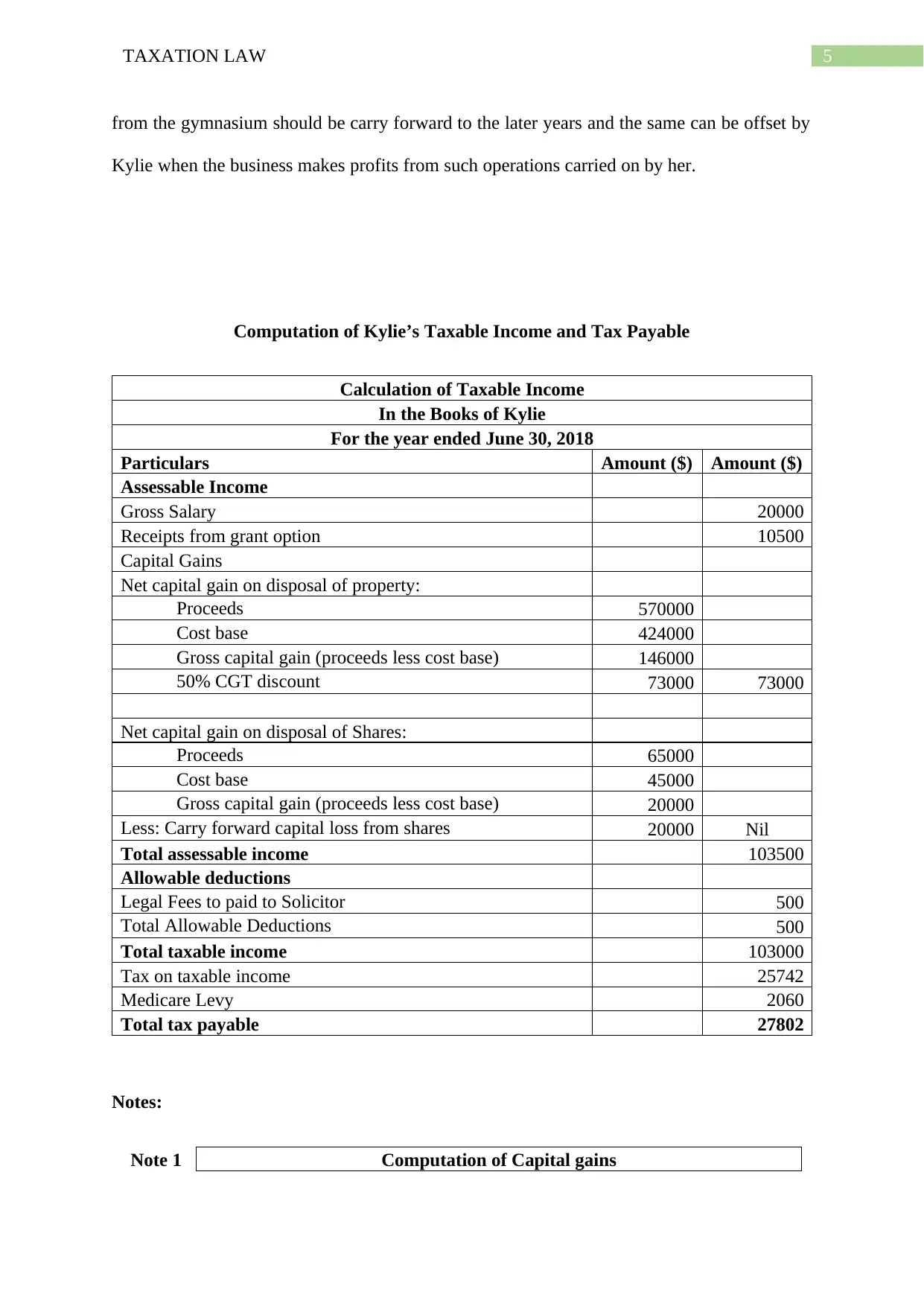
5TAXATION LAW
from the gymnasium should be carry forward to the later years and the same can be offset by
Kylie when the business makes profits from such operations carried on by her.
Computation of Kylie’s Taxable Income and Tax Payable
Calculation of Taxable Income
In the Books of Kylie
For the year ended June 30, 2018
Particulars Amount ($) Amount ($)
Assessable Income
Gross Salary 20000
Receipts from grant option 10500
Capital Gains
Net capital gain on disposal of property:
Proceeds 570000
Cost base 424000
Gross capital gain (proceeds less cost base) 146000
50% CGT discount 73000 73000
Net capital gain on disposal of Shares:
Proceeds 65000
Cost base 45000
Gross capital gain (proceeds less cost base) 20000
Less: Carry forward capital loss from shares 20000 Nil
Total assessable income 103500
Allowable deductions
Legal Fees to paid to Solicitor 500
Total Allowable Deductions 500
Total taxable income 103000
Tax on taxable income 25742
Medicare Levy 2060
Total tax payable 27802
Notes:
Note 1 Computation of Capital gains
from the gymnasium should be carry forward to the later years and the same can be offset by
Kylie when the business makes profits from such operations carried on by her.
Computation of Kylie’s Taxable Income and Tax Payable
Calculation of Taxable Income
In the Books of Kylie
For the year ended June 30, 2018
Particulars Amount ($) Amount ($)
Assessable Income
Gross Salary 20000
Receipts from grant option 10500
Capital Gains
Net capital gain on disposal of property:
Proceeds 570000
Cost base 424000
Gross capital gain (proceeds less cost base) 146000
50% CGT discount 73000 73000
Net capital gain on disposal of Shares:
Proceeds 65000
Cost base 45000
Gross capital gain (proceeds less cost base) 20000
Less: Carry forward capital loss from shares 20000 Nil
Total assessable income 103500
Allowable deductions
Legal Fees to paid to Solicitor 500
Total Allowable Deductions 500
Total taxable income 103000
Tax on taxable income 25742
Medicare Levy 2060
Total tax payable 27802
Notes:
Note 1 Computation of Capital gains
⊘ This is a preview!⊘
Do you want full access?
Subscribe today to unlock all pages.

Trusted by 1+ million students worldwide
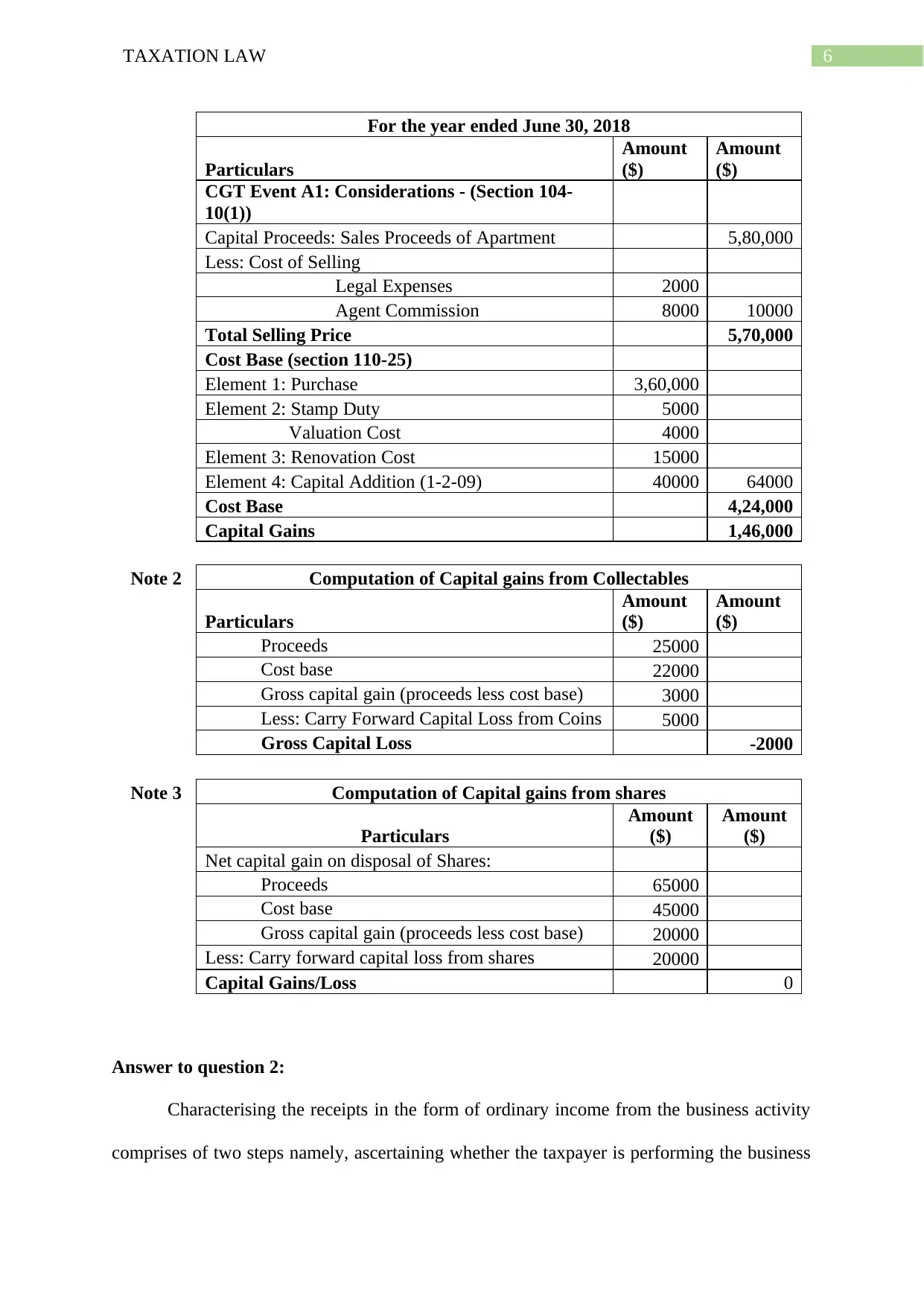
6TAXATION LAW
For the year ended June 30, 2018
Particulars
Amount
($)
Amount
($)
CGT Event A1: Considerations - (Section 104-
10(1))
Capital Proceeds: Sales Proceeds of Apartment 5,80,000
Less: Cost of Selling
Legal Expenses 2000
Agent Commission 8000 10000
Total Selling Price 5,70,000
Cost Base (section 110-25)
Element 1: Purchase 3,60,000
Element 2: Stamp Duty 5000
Valuation Cost 4000
Element 3: Renovation Cost 15000
Element 4: Capital Addition (1-2-09) 40000 64000
Cost Base 4,24,000
Capital Gains 1,46,000
Note 2 Computation of Capital gains from Collectables
Particulars
Amount
($)
Amount
($)
Proceeds 25000
Cost base 22000
Gross capital gain (proceeds less cost base) 3000
Less: Carry Forward Capital Loss from Coins 5000
Gross Capital Loss -2000
Note 3 Computation of Capital gains from shares
Particulars
Amount
($)
Amount
($)
Net capital gain on disposal of Shares:
Proceeds 65000
Cost base 45000
Gross capital gain (proceeds less cost base) 20000
Less: Carry forward capital loss from shares 20000
Capital Gains/Loss 0
Answer to question 2:
Characterising the receipts in the form of ordinary income from the business activity
comprises of two steps namely, ascertaining whether the taxpayer is performing the business
For the year ended June 30, 2018
Particulars
Amount
($)
Amount
($)
CGT Event A1: Considerations - (Section 104-
10(1))
Capital Proceeds: Sales Proceeds of Apartment 5,80,000
Less: Cost of Selling
Legal Expenses 2000
Agent Commission 8000 10000
Total Selling Price 5,70,000
Cost Base (section 110-25)
Element 1: Purchase 3,60,000
Element 2: Stamp Duty 5000
Valuation Cost 4000
Element 3: Renovation Cost 15000
Element 4: Capital Addition (1-2-09) 40000 64000
Cost Base 4,24,000
Capital Gains 1,46,000
Note 2 Computation of Capital gains from Collectables
Particulars
Amount
($)
Amount
($)
Proceeds 25000
Cost base 22000
Gross capital gain (proceeds less cost base) 3000
Less: Carry Forward Capital Loss from Coins 5000
Gross Capital Loss -2000
Note 3 Computation of Capital gains from shares
Particulars
Amount
($)
Amount
($)
Net capital gain on disposal of Shares:
Proceeds 65000
Cost base 45000
Gross capital gain (proceeds less cost base) 20000
Less: Carry forward capital loss from shares 20000
Capital Gains/Loss 0
Answer to question 2:
Characterising the receipts in the form of ordinary income from the business activity
comprises of two steps namely, ascertaining whether the taxpayer is performing the business
Paraphrase This Document
Need a fresh take? Get an instant paraphrase of this document with our AI Paraphraser
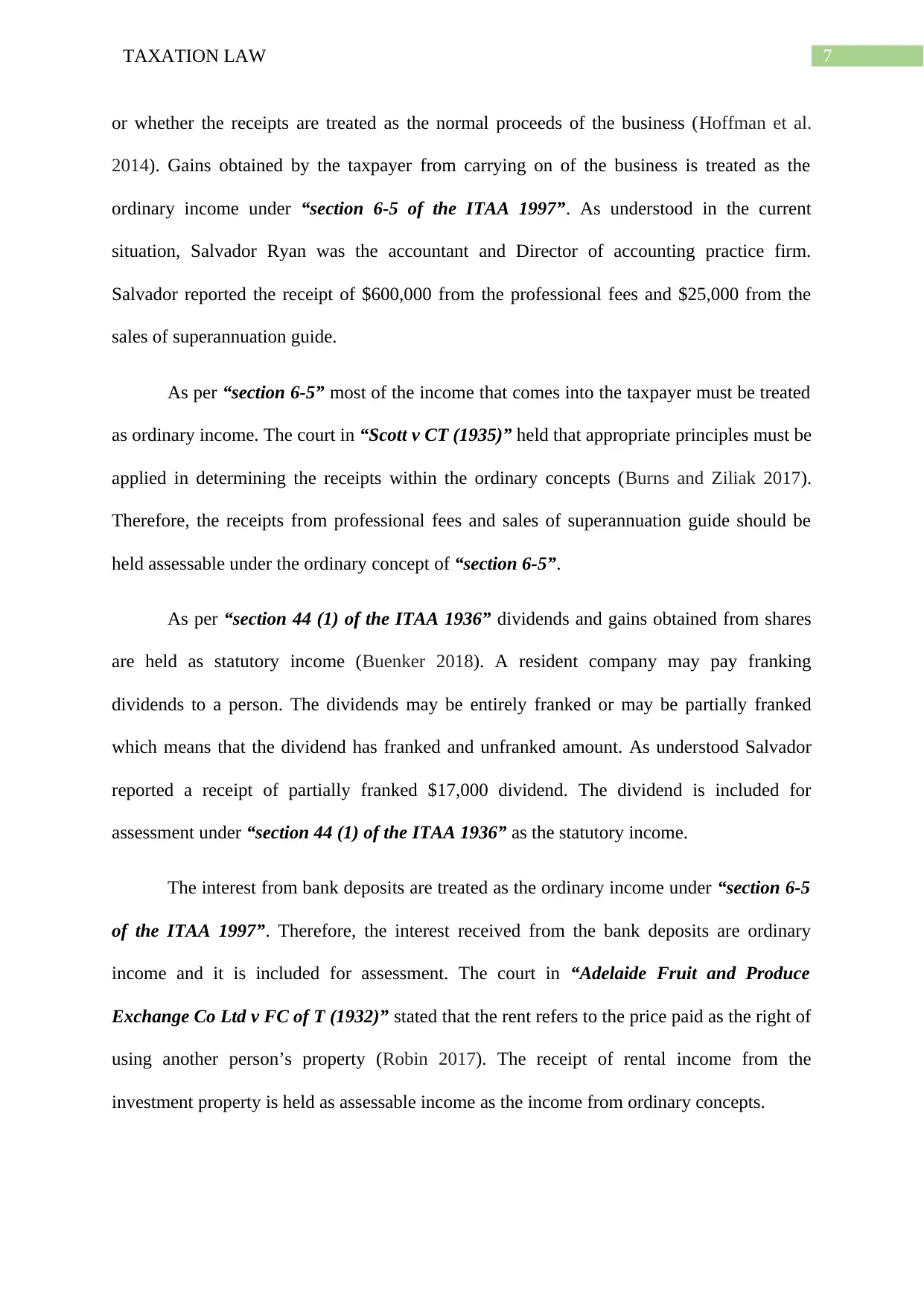
7TAXATION LAW
or whether the receipts are treated as the normal proceeds of the business (Hoffman et al.
2014). Gains obtained by the taxpayer from carrying on of the business is treated as the
ordinary income under “section 6-5 of the ITAA 1997”. As understood in the current
situation, Salvador Ryan was the accountant and Director of accounting practice firm.
Salvador reported the receipt of $600,000 from the professional fees and $25,000 from the
sales of superannuation guide.
As per “section 6-5” most of the income that comes into the taxpayer must be treated
as ordinary income. The court in “Scott v CT (1935)” held that appropriate principles must be
applied in determining the receipts within the ordinary concepts (Burns and Ziliak 2017).
Therefore, the receipts from professional fees and sales of superannuation guide should be
held assessable under the ordinary concept of “section 6-5”.
As per “section 44 (1) of the ITAA 1936” dividends and gains obtained from shares
are held as statutory income (Buenker 2018). A resident company may pay franking
dividends to a person. The dividends may be entirely franked or may be partially franked
which means that the dividend has franked and unfranked amount. As understood Salvador
reported a receipt of partially franked $17,000 dividend. The dividend is included for
assessment under “section 44 (1) of the ITAA 1936” as the statutory income.
The interest from bank deposits are treated as the ordinary income under “section 6-5
of the ITAA 1997”. Therefore, the interest received from the bank deposits are ordinary
income and it is included for assessment. The court in “Adelaide Fruit and Produce
Exchange Co Ltd v FC of T (1932)” stated that the rent refers to the price paid as the right of
using another person’s property (Robin 2017). The receipt of rental income from the
investment property is held as assessable income as the income from ordinary concepts.
or whether the receipts are treated as the normal proceeds of the business (Hoffman et al.
2014). Gains obtained by the taxpayer from carrying on of the business is treated as the
ordinary income under “section 6-5 of the ITAA 1997”. As understood in the current
situation, Salvador Ryan was the accountant and Director of accounting practice firm.
Salvador reported the receipt of $600,000 from the professional fees and $25,000 from the
sales of superannuation guide.
As per “section 6-5” most of the income that comes into the taxpayer must be treated
as ordinary income. The court in “Scott v CT (1935)” held that appropriate principles must be
applied in determining the receipts within the ordinary concepts (Burns and Ziliak 2017).
Therefore, the receipts from professional fees and sales of superannuation guide should be
held assessable under the ordinary concept of “section 6-5”.
As per “section 44 (1) of the ITAA 1936” dividends and gains obtained from shares
are held as statutory income (Buenker 2018). A resident company may pay franking
dividends to a person. The dividends may be entirely franked or may be partially franked
which means that the dividend has franked and unfranked amount. As understood Salvador
reported a receipt of partially franked $17,000 dividend. The dividend is included for
assessment under “section 44 (1) of the ITAA 1936” as the statutory income.
The interest from bank deposits are treated as the ordinary income under “section 6-5
of the ITAA 1997”. Therefore, the interest received from the bank deposits are ordinary
income and it is included for assessment. The court in “Adelaide Fruit and Produce
Exchange Co Ltd v FC of T (1932)” stated that the rent refers to the price paid as the right of
using another person’s property (Robin 2017). The receipt of rental income from the
investment property is held as assessable income as the income from ordinary concepts.
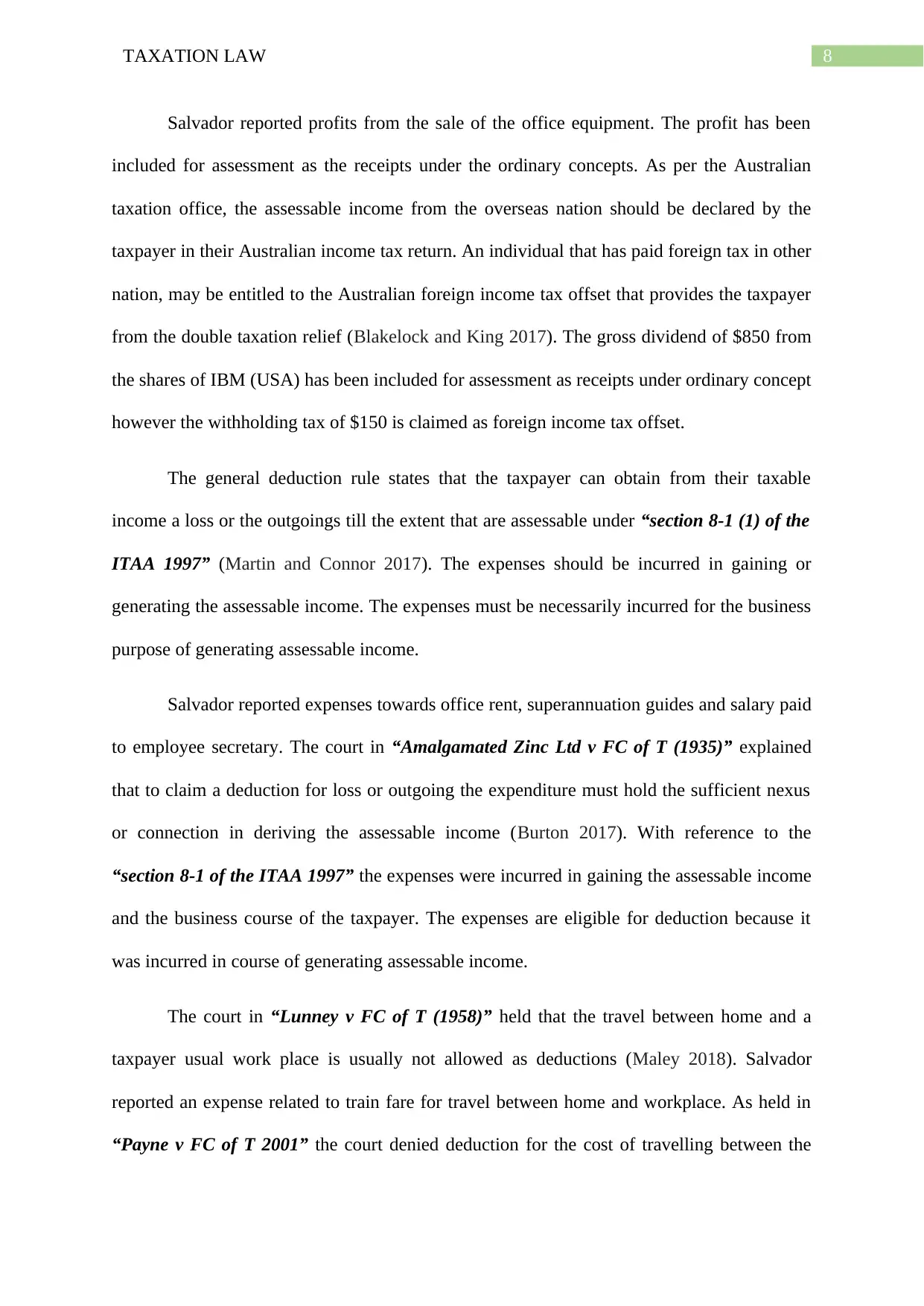
8TAXATION LAW
Salvador reported profits from the sale of the office equipment. The profit has been
included for assessment as the receipts under the ordinary concepts. As per the Australian
taxation office, the assessable income from the overseas nation should be declared by the
taxpayer in their Australian income tax return. An individual that has paid foreign tax in other
nation, may be entitled to the Australian foreign income tax offset that provides the taxpayer
from the double taxation relief (Blakelock and King 2017). The gross dividend of $850 from
the shares of IBM (USA) has been included for assessment as receipts under ordinary concept
however the withholding tax of $150 is claimed as foreign income tax offset.
The general deduction rule states that the taxpayer can obtain from their taxable
income a loss or the outgoings till the extent that are assessable under “section 8-1 (1) of the
ITAA 1997” (Martin and Connor 2017). The expenses should be incurred in gaining or
generating the assessable income. The expenses must be necessarily incurred for the business
purpose of generating assessable income.
Salvador reported expenses towards office rent, superannuation guides and salary paid
to employee secretary. The court in “Amalgamated Zinc Ltd v FC of T (1935)” explained
that to claim a deduction for loss or outgoing the expenditure must hold the sufficient nexus
or connection in deriving the assessable income (Burton 2017). With reference to the
“section 8-1 of the ITAA 1997” the expenses were incurred in gaining the assessable income
and the business course of the taxpayer. The expenses are eligible for deduction because it
was incurred in course of generating assessable income.
The court in “Lunney v FC of T (1958)” held that the travel between home and a
taxpayer usual work place is usually not allowed as deductions (Maley 2018). Salvador
reported an expense related to train fare for travel between home and workplace. As held in
“Payne v FC of T 2001” the court denied deduction for the cost of travelling between the
Salvador reported profits from the sale of the office equipment. The profit has been
included for assessment as the receipts under the ordinary concepts. As per the Australian
taxation office, the assessable income from the overseas nation should be declared by the
taxpayer in their Australian income tax return. An individual that has paid foreign tax in other
nation, may be entitled to the Australian foreign income tax offset that provides the taxpayer
from the double taxation relief (Blakelock and King 2017). The gross dividend of $850 from
the shares of IBM (USA) has been included for assessment as receipts under ordinary concept
however the withholding tax of $150 is claimed as foreign income tax offset.
The general deduction rule states that the taxpayer can obtain from their taxable
income a loss or the outgoings till the extent that are assessable under “section 8-1 (1) of the
ITAA 1997” (Martin and Connor 2017). The expenses should be incurred in gaining or
generating the assessable income. The expenses must be necessarily incurred for the business
purpose of generating assessable income.
Salvador reported expenses towards office rent, superannuation guides and salary paid
to employee secretary. The court in “Amalgamated Zinc Ltd v FC of T (1935)” explained
that to claim a deduction for loss or outgoing the expenditure must hold the sufficient nexus
or connection in deriving the assessable income (Burton 2017). With reference to the
“section 8-1 of the ITAA 1997” the expenses were incurred in gaining the assessable income
and the business course of the taxpayer. The expenses are eligible for deduction because it
was incurred in course of generating assessable income.
The court in “Lunney v FC of T (1958)” held that the travel between home and a
taxpayer usual work place is usually not allowed as deductions (Maley 2018). Salvador
reported an expense related to train fare for travel between home and workplace. As held in
“Payne v FC of T 2001” the court denied deduction for the cost of travelling between the
⊘ This is a preview!⊘
Do you want full access?
Subscribe today to unlock all pages.

Trusted by 1+ million students worldwide
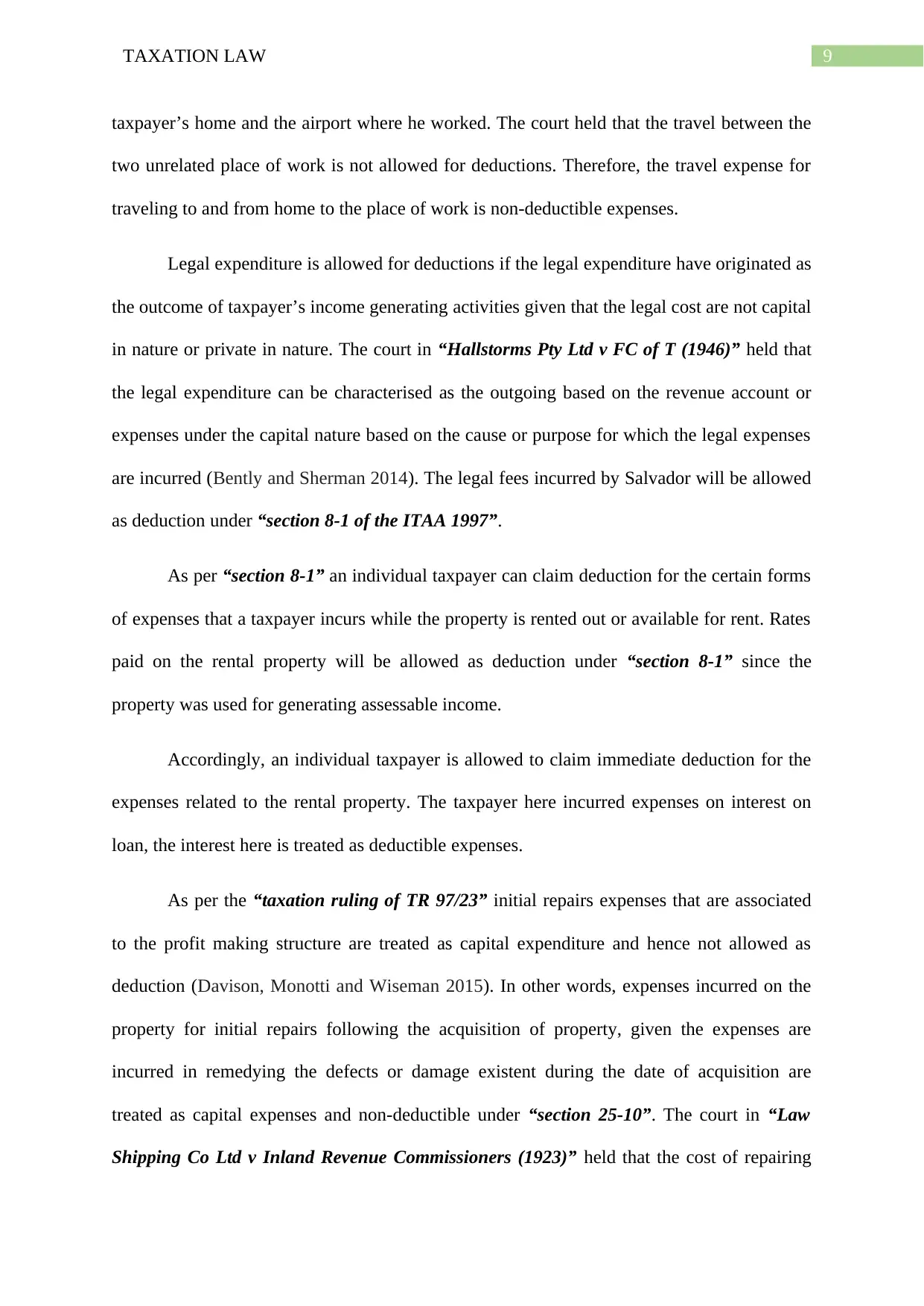
9TAXATION LAW
taxpayer’s home and the airport where he worked. The court held that the travel between the
two unrelated place of work is not allowed for deductions. Therefore, the travel expense for
traveling to and from home to the place of work is non-deductible expenses.
Legal expenditure is allowed for deductions if the legal expenditure have originated as
the outcome of taxpayer’s income generating activities given that the legal cost are not capital
in nature or private in nature. The court in “Hallstorms Pty Ltd v FC of T (1946)” held that
the legal expenditure can be characterised as the outgoing based on the revenue account or
expenses under the capital nature based on the cause or purpose for which the legal expenses
are incurred (Bently and Sherman 2014). The legal fees incurred by Salvador will be allowed
as deduction under “section 8-1 of the ITAA 1997”.
As per “section 8-1” an individual taxpayer can claim deduction for the certain forms
of expenses that a taxpayer incurs while the property is rented out or available for rent. Rates
paid on the rental property will be allowed as deduction under “section 8-1” since the
property was used for generating assessable income.
Accordingly, an individual taxpayer is allowed to claim immediate deduction for the
expenses related to the rental property. The taxpayer here incurred expenses on interest on
loan, the interest here is treated as deductible expenses.
As per the “taxation ruling of TR 97/23” initial repairs expenses that are associated
to the profit making structure are treated as capital expenditure and hence not allowed as
deduction (Davison, Monotti and Wiseman 2015). In other words, expenses incurred on the
property for initial repairs following the acquisition of property, given the expenses are
incurred in remedying the defects or damage existent during the date of acquisition are
treated as capital expenses and non-deductible under “section 25-10”. The court in “Law
Shipping Co Ltd v Inland Revenue Commissioners (1923)” held that the cost of repairing
taxpayer’s home and the airport where he worked. The court held that the travel between the
two unrelated place of work is not allowed for deductions. Therefore, the travel expense for
traveling to and from home to the place of work is non-deductible expenses.
Legal expenditure is allowed for deductions if the legal expenditure have originated as
the outcome of taxpayer’s income generating activities given that the legal cost are not capital
in nature or private in nature. The court in “Hallstorms Pty Ltd v FC of T (1946)” held that
the legal expenditure can be characterised as the outgoing based on the revenue account or
expenses under the capital nature based on the cause or purpose for which the legal expenses
are incurred (Bently and Sherman 2014). The legal fees incurred by Salvador will be allowed
as deduction under “section 8-1 of the ITAA 1997”.
As per “section 8-1” an individual taxpayer can claim deduction for the certain forms
of expenses that a taxpayer incurs while the property is rented out or available for rent. Rates
paid on the rental property will be allowed as deduction under “section 8-1” since the
property was used for generating assessable income.
Accordingly, an individual taxpayer is allowed to claim immediate deduction for the
expenses related to the rental property. The taxpayer here incurred expenses on interest on
loan, the interest here is treated as deductible expenses.
As per the “taxation ruling of TR 97/23” initial repairs expenses that are associated
to the profit making structure are treated as capital expenditure and hence not allowed as
deduction (Davison, Monotti and Wiseman 2015). In other words, expenses incurred on the
property for initial repairs following the acquisition of property, given the expenses are
incurred in remedying the defects or damage existent during the date of acquisition are
treated as capital expenses and non-deductible under “section 25-10”. The court in “Law
Shipping Co Ltd v Inland Revenue Commissioners (1923)” held that the cost of repairing
Paraphrase This Document
Need a fresh take? Get an instant paraphrase of this document with our AI Paraphraser
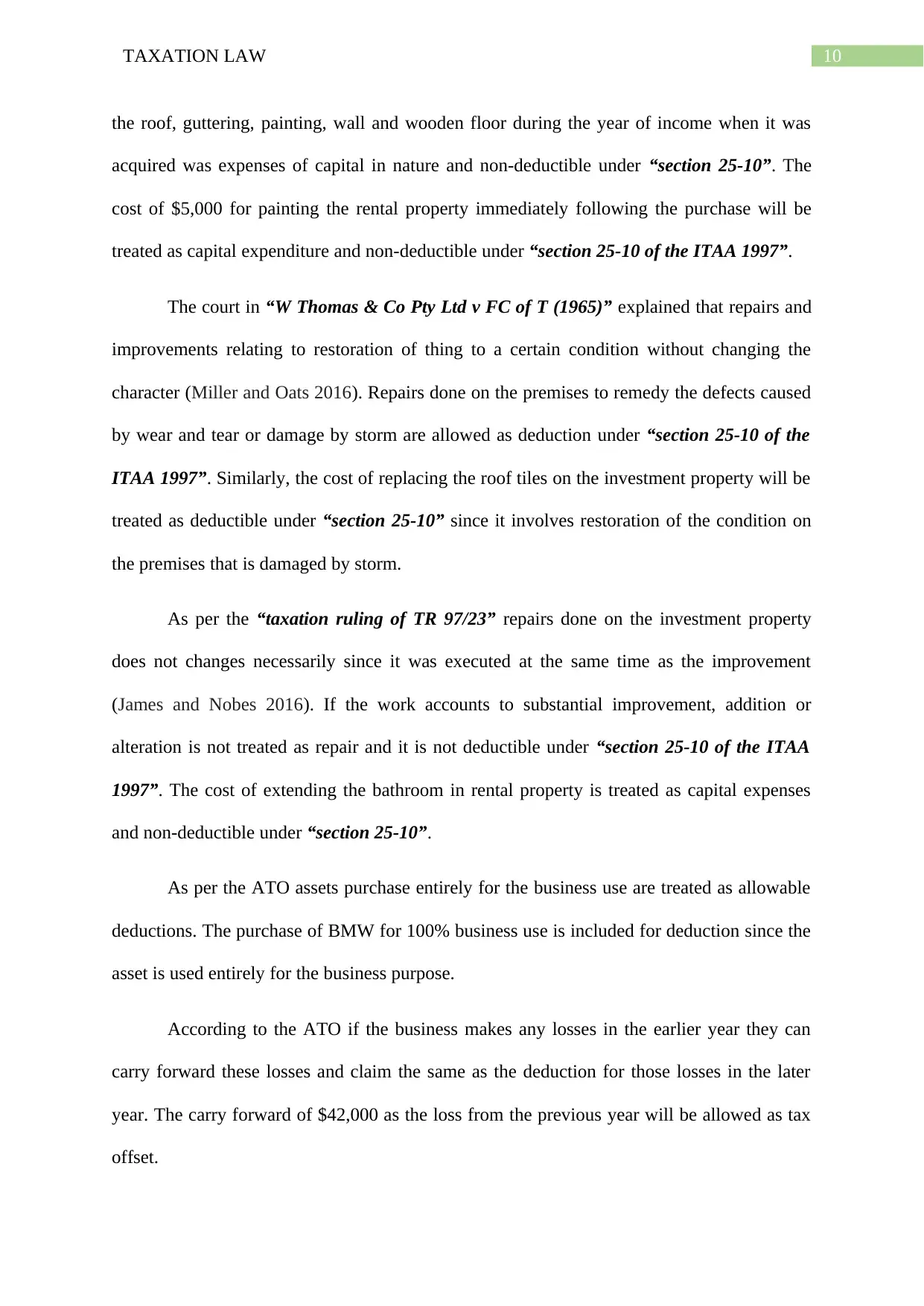
10TAXATION LAW
the roof, guttering, painting, wall and wooden floor during the year of income when it was
acquired was expenses of capital in nature and non-deductible under “section 25-10”. The
cost of $5,000 for painting the rental property immediately following the purchase will be
treated as capital expenditure and non-deductible under “section 25-10 of the ITAA 1997”.
The court in “W Thomas & Co Pty Ltd v FC of T (1965)” explained that repairs and
improvements relating to restoration of thing to a certain condition without changing the
character (Miller and Oats 2016). Repairs done on the premises to remedy the defects caused
by wear and tear or damage by storm are allowed as deduction under “section 25-10 of the
ITAA 1997”. Similarly, the cost of replacing the roof tiles on the investment property will be
treated as deductible under “section 25-10” since it involves restoration of the condition on
the premises that is damaged by storm.
As per the “taxation ruling of TR 97/23” repairs done on the investment property
does not changes necessarily since it was executed at the same time as the improvement
(James and Nobes 2016). If the work accounts to substantial improvement, addition or
alteration is not treated as repair and it is not deductible under “section 25-10 of the ITAA
1997”. The cost of extending the bathroom in rental property is treated as capital expenses
and non-deductible under “section 25-10”.
As per the ATO assets purchase entirely for the business use are treated as allowable
deductions. The purchase of BMW for 100% business use is included for deduction since the
asset is used entirely for the business purpose.
According to the ATO if the business makes any losses in the earlier year they can
carry forward these losses and claim the same as the deduction for those losses in the later
year. The carry forward of $42,000 as the loss from the previous year will be allowed as tax
offset.
the roof, guttering, painting, wall and wooden floor during the year of income when it was
acquired was expenses of capital in nature and non-deductible under “section 25-10”. The
cost of $5,000 for painting the rental property immediately following the purchase will be
treated as capital expenditure and non-deductible under “section 25-10 of the ITAA 1997”.
The court in “W Thomas & Co Pty Ltd v FC of T (1965)” explained that repairs and
improvements relating to restoration of thing to a certain condition without changing the
character (Miller and Oats 2016). Repairs done on the premises to remedy the defects caused
by wear and tear or damage by storm are allowed as deduction under “section 25-10 of the
ITAA 1997”. Similarly, the cost of replacing the roof tiles on the investment property will be
treated as deductible under “section 25-10” since it involves restoration of the condition on
the premises that is damaged by storm.
As per the “taxation ruling of TR 97/23” repairs done on the investment property
does not changes necessarily since it was executed at the same time as the improvement
(James and Nobes 2016). If the work accounts to substantial improvement, addition or
alteration is not treated as repair and it is not deductible under “section 25-10 of the ITAA
1997”. The cost of extending the bathroom in rental property is treated as capital expenses
and non-deductible under “section 25-10”.
As per the ATO assets purchase entirely for the business use are treated as allowable
deductions. The purchase of BMW for 100% business use is included for deduction since the
asset is used entirely for the business purpose.
According to the ATO if the business makes any losses in the earlier year they can
carry forward these losses and claim the same as the deduction for those losses in the later
year. The carry forward of $42,000 as the loss from the previous year will be allowed as tax
offset.
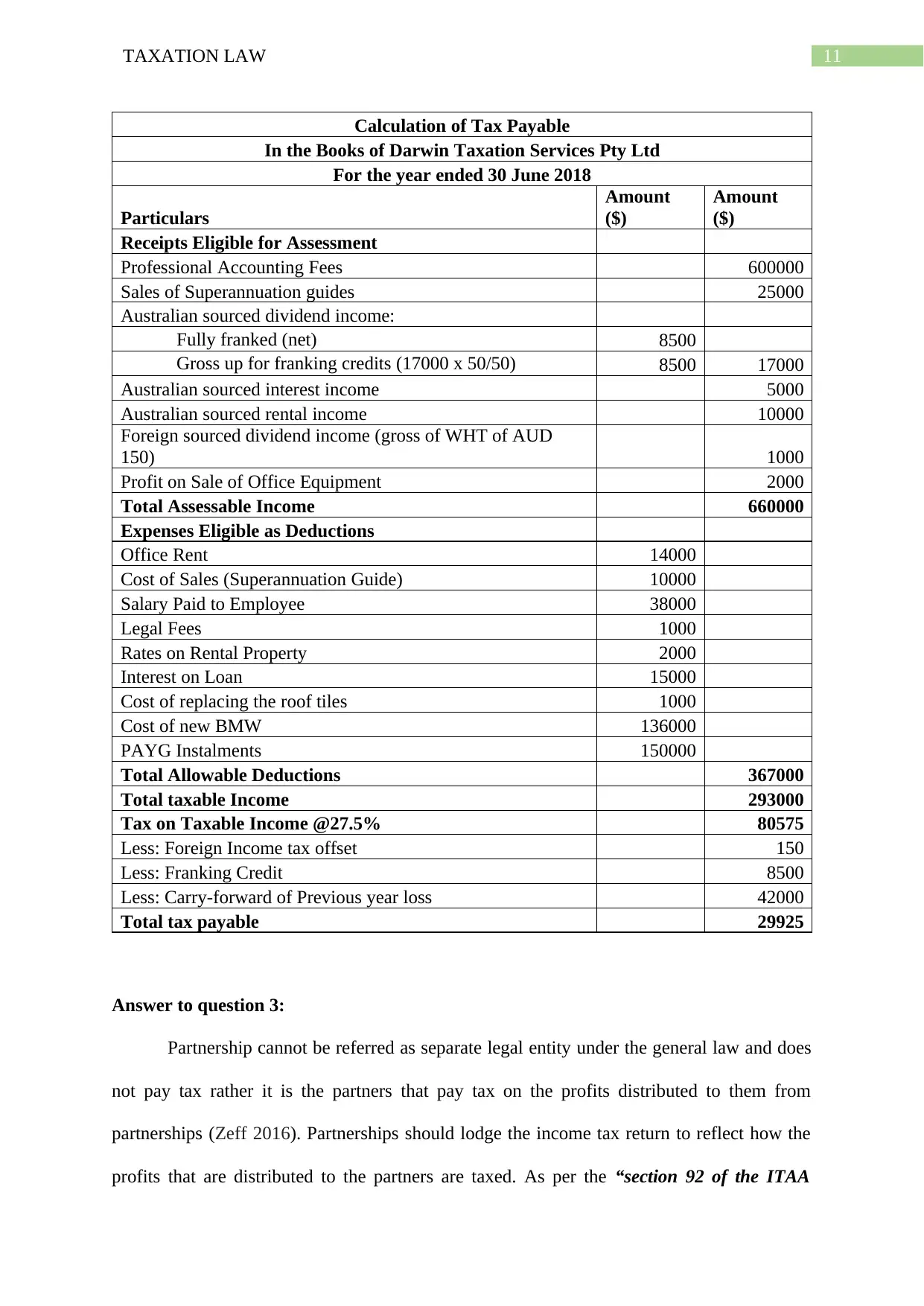
11TAXATION LAW
Calculation of Tax Payable
In the Books of Darwin Taxation Services Pty Ltd
For the year ended 30 June 2018
Particulars
Amount
($)
Amount
($)
Receipts Eligible for Assessment
Professional Accounting Fees 600000
Sales of Superannuation guides 25000
Australian sourced dividend income:
Fully franked (net) 8500
Gross up for franking credits (17000 x 50/50) 8500 17000
Australian sourced interest income 5000
Australian sourced rental income 10000
Foreign sourced dividend income (gross of WHT of AUD
150) 1000
Profit on Sale of Office Equipment 2000
Total Assessable Income 660000
Expenses Eligible as Deductions
Office Rent 14000
Cost of Sales (Superannuation Guide) 10000
Salary Paid to Employee 38000
Legal Fees 1000
Rates on Rental Property 2000
Interest on Loan 15000
Cost of replacing the roof tiles 1000
Cost of new BMW 136000
PAYG Instalments 150000
Total Allowable Deductions 367000
Total taxable Income 293000
Tax on Taxable Income @27.5% 80575
Less: Foreign Income tax offset 150
Less: Franking Credit 8500
Less: Carry-forward of Previous year loss 42000
Total tax payable 29925
Answer to question 3:
Partnership cannot be referred as separate legal entity under the general law and does
not pay tax rather it is the partners that pay tax on the profits distributed to them from
partnerships (Zeff 2016). Partnerships should lodge the income tax return to reflect how the
profits that are distributed to the partners are taxed. As per the “section 92 of the ITAA
Calculation of Tax Payable
In the Books of Darwin Taxation Services Pty Ltd
For the year ended 30 June 2018
Particulars
Amount
($)
Amount
($)
Receipts Eligible for Assessment
Professional Accounting Fees 600000
Sales of Superannuation guides 25000
Australian sourced dividend income:
Fully franked (net) 8500
Gross up for franking credits (17000 x 50/50) 8500 17000
Australian sourced interest income 5000
Australian sourced rental income 10000
Foreign sourced dividend income (gross of WHT of AUD
150) 1000
Profit on Sale of Office Equipment 2000
Total Assessable Income 660000
Expenses Eligible as Deductions
Office Rent 14000
Cost of Sales (Superannuation Guide) 10000
Salary Paid to Employee 38000
Legal Fees 1000
Rates on Rental Property 2000
Interest on Loan 15000
Cost of replacing the roof tiles 1000
Cost of new BMW 136000
PAYG Instalments 150000
Total Allowable Deductions 367000
Total taxable Income 293000
Tax on Taxable Income @27.5% 80575
Less: Foreign Income tax offset 150
Less: Franking Credit 8500
Less: Carry-forward of Previous year loss 42000
Total tax payable 29925
Answer to question 3:
Partnership cannot be referred as separate legal entity under the general law and does
not pay tax rather it is the partners that pay tax on the profits distributed to them from
partnerships (Zeff 2016). Partnerships should lodge the income tax return to reflect how the
profits that are distributed to the partners are taxed. As per the “section 92 of the ITAA
⊘ This is a preview!⊘
Do you want full access?
Subscribe today to unlock all pages.

Trusted by 1+ million students worldwide
1 out of 22
Related Documents
Your All-in-One AI-Powered Toolkit for Academic Success.
+13062052269
info@desklib.com
Available 24*7 on WhatsApp / Email
![[object Object]](/_next/static/media/star-bottom.7253800d.svg)
Unlock your academic potential
Copyright © 2020–2025 A2Z Services. All Rights Reserved. Developed and managed by ZUCOL.





